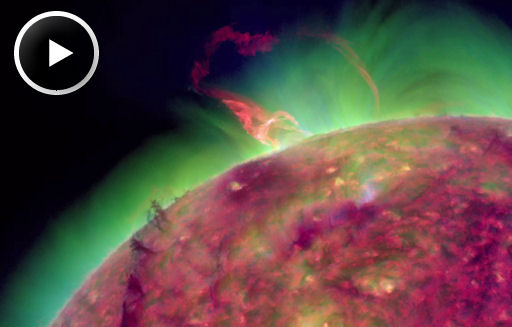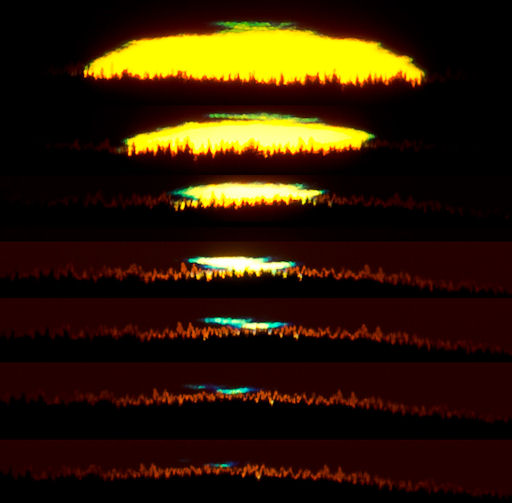Listen to radar echoes from satellites and meteors, live on listener-supported Space Weather Radio. | | | CURIOSITY'S SEVEN MINUTES OF TERROR: In a new must-see video from NASA, Mars Science Lab team members preview the "seven minutes of terror" in store for Curiosity as the rover prepres to land on the Red Planet. Highly recommended. PHOTOGENIC, NOT GEOEFFECTIVE: A long filament of magnetism snaking over the sun's northwestern limb erupted this morning, hurling much of itself into space. NASA's Solar Dynamics Observatory recorded the blast: 
A bright CME billowed away from the blast site. Because of the explosion's location on the NW edge of the solar disk, the cloud will not hit Earth. This event was photogenic but not geoeffective. Solar flare alerts: text, voice. Realtime Space Weather Photo Gallery GREEN FLASH, BLUE FLASH: Green flashes at sunset are rare. Indeed, they were once thought mythological. Blue flashes are rarer still. On June 21st Göran Strand of Frösön, Sweden, saw them both in a single sunset: 
"Tonight the weather was incredibly clear and fine, so I went out to photograph the sunset--and this was the result," says Strand. "The time interval between the first and last frames is 1 minute and 14 seconds." Green flashes are formed when the prismatic action of the atmosphere splits the setting sun into basic R-G-B colors. Temperature inversions create a mirage, magnifying the green into an eye-catching flash. Blues flashes are formed in the same way, but they are generally harder to see than green flashes, because blue flashes blend into the surrounding blue sky. When the air is exceptionally clear, however, the blue flash emerges. For more rare sights occuring right now, browse the new Realtime Space Weather Photo Gallery. Potentially Hazardous Asteroids ( PHAs) are space rocks larger than approximately 100m that can come closer to Earth than 0.05 AU. None of the known PHAs is on a collision course with our planet, although astronomers are finding new ones all the time. On June 23, 2012 there were potentially hazardous asteroids. Notes: LD means "Lunar Distance." 1 LD = 384,401 km, the distance between Earth and the Moon. 1 LD also equals 0.00256 AU. MAG is the visual magnitude of the asteroid on the date of closest approach. | | The official U.S. government space weather bureau | | | The first place to look for information about sundogs, pillars, rainbows and related phenomena. | | | Researchers call it a "Hubble for the sun." SDO is the most advanced solar observatory ever. | | | 3D views of the sun from NASA's Solar and Terrestrial Relations Observatory | | | Realtime and archival images of the Sun from SOHO. | | | from the NOAA Space Environment Center | | | the underlying science of space weather | | 
